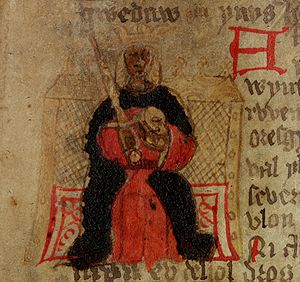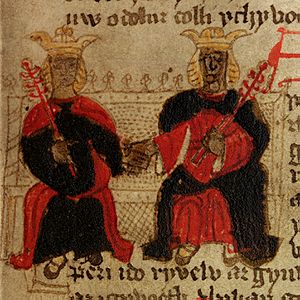Brut y Brenhinedd facts for kids
The Brut y Brenhinedd (which means "Chronicle of the Kings") is a collection of old Welsh stories. These stories are different versions of a famous Latin book called Historia Regum Britanniae by Geoffrey of Monmouth. About 60 copies of the Brut still exist today. The oldest ones are from the mid-1200s. Geoffrey's original book was very popular in Europe during the Middle Ages. But the Brut was especially important in medieval Wales. People there believed it was a true history of the early Celtic Britons.
Contents
Brut y Brenhinedd: The Chronicle of Kings
Geoffrey of Monmouth finished his book, Historia Regum Britanniae, around 1139. It claimed to tell the history of the Kings of Britain. It started with Brutus of Troy, who the book says founded Britain. It ended with Cadwaladr, the last king in that line. Geoffrey said he based his history on a "very ancient book" written in an old British language. He said he got this book from Walter of Oxford.
Geoffrey's Historia became one of the most popular books in the Middle Ages. Its impact was very strong in Wales. People in Wales accepted the Historia as a real and important history. We know this because many Welsh translations appeared from the 1200s onwards. These translations are usually known as Brut y Brenhinedd. Many copies of these texts were made over time. This shows how important they were.
The Welsh versions are not exact, word-for-word translations. But for their time, they were quite close to Geoffrey's Latin book. They sometimes added comments or extra stories from old Welsh traditions. For example, some versions include the tale of Lludd and Llefelys. This story is about a king named Lludd Llaw Eraint. The presence or absence of this tale helps scholars sort the early versions of the Brut. Welsh translators also changed some names to fit Welsh traditions. For example, Geoffrey's "Heli" became Beli Mawr. Beli Mawr is an important ancestor in other old Welsh stories.
Different Versions of the Brut
There are about sixty different copies of the Welsh Brut in old manuscripts. Experts like Brynley F. Roberts have grouped these versions into six main types:
- Dingestow MS.
- Peniarth 44
- Llanstephan 1
- Peniarth 21
- Cotton Cleopatra B. v
- The Brut Tysilio
13th Century Versions
- The Brut in NLW, Llanstephan MS 1, is from the mid-1200s. It is a very close translation of Geoffrey's Historia.
- The Brut in NLW, Peniarth MS 44, also from the mid-1200s. This text gets shorter towards the end. It leaves out Merlin's prophecy because it says it's not believable. But it was the first Brut to include the story of Lludd and Llefelys.
- Brut Dingestow is from later in the 1200s. It is now in MS Aberystwyth, NLW 5266. This text is also a very faithful translation. It sometimes used Llanstephan MS 1 as a guide.
Llanstephan MS 1 and Brut Dingestow were very important. Many later copies of the Brut from the 1200s onwards were based on these two versions.
14th Century Versions
- Red Book of Hergest version: A new version was made, probably in south Wales. It followed the Dingestow version for the first part. Then it switched to the Llanstephan 1 version. This combined version is found in many manuscripts. The most famous is the Llyfr Coch Hergest or Red Book of Hergest. In most manuscripts, this Brut is placed in the middle of a larger history. It starts with the Ystorya Dared, a Welsh translation of a story about the Trojan War. It ends with the Brut y Tywysogion, which tells about events closer to the time the book was written.
- The Brut in NLW Peniarth MS 23 is another new translation. It is also quite close to Geoffrey's Historia.
- The Brut in BL Cotton Cleopatra B. v was popular in north-east Wales. This version is more free and lively. It includes material from other sources. These include Wace's Roman de Brut (a French book based on Geoffrey's work) and a Latin timeline. This Brut is often found between the Ystorya Dared and the Brenhinoedd y Saeson (Kings of the English). The Brenhinoedd y Saeson is a version of the Brut y Tywysogion that includes English history. This version also has a shorter version of the Lludd and Llefelys tale.
Brut Tysilio: A Special Version
The version known as the Brut Tysilio became more famous in the early 1800s. It was published in a collection called The Myvyrian Archaiology of Wales. This collection was put together by people who sometimes added fake old texts. The Brut Tysilio was said to be written by a Welsh saint named Tysilio from the 600s.
At the very end of the Brut Tysilio, there is a note. It says that Walter, Archdeacon of Oxford, translated the book from Welsh to Latin. Then, in his old age, he translated it back from Latin to Welsh. Because of this note, some people thought the Brut Tysilio might be the "very ancient book" that Geoffrey of Monmouth claimed to have used.
However, modern experts have studied these texts very carefully. They have found that all the Welsh versions we have today came from Geoffrey's Latin book. They did not come from an older Welsh book. Experts have shown that the Brut Tysilio is a mix of different versions. It was put together much later, around the 1500s. So, it is not the ancient source Geoffrey talked about.



